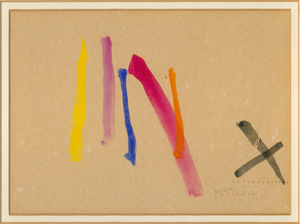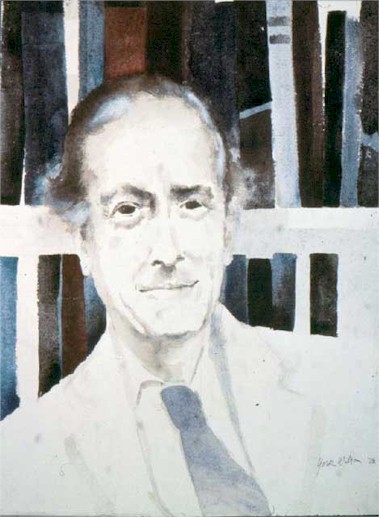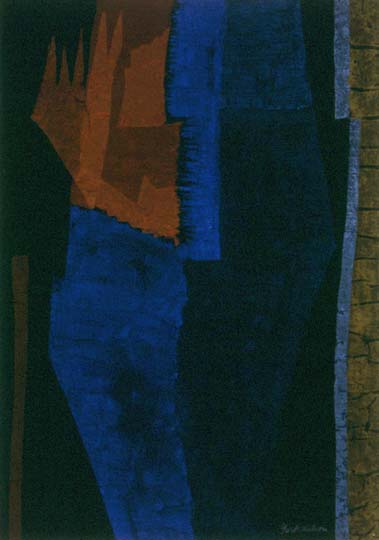
| Video Archives |
| Appreciation |
| John Harris |
| Ray Cattell |
| Eric McLuhan |
| Ron Moore |
| Charles Pachter |
| David Partridge |
| Bob Paterson |
| Video Archives Home |
| Critical Insight |
| Documentary |
|
Eric McLuhan |
|||
|
Eric McLuhan is currently Associate Director of the McLuhan Program International. Dr. Eric McLuhan lectures throughout the world on communication theory and media. He collaborated with his father, the late Marshall McLuhan (1911-1980) on The Medium is the Message and War and Peace in the Global Village prior to publishing Laws of Media. |
 |
||
Videoclip Segment: Foreword Marshall McLuhan wrote the following Foreword in art critic Paul Duval's book on YORK WILSON: In the nuclear age abstract or non-objective art is plainly prophetic. On the phone or on the air the user of electric services has no physical body. We are discarnate people, figures in an instantaneous and invisible ground of energy and vibration. This resonant and acoustic ground is discontinuous and man-made, deeply involving and subjective yet minus any point of view or personal stress. The work of York Wilson is a notable manifestation of the new awareness of nuclear man, the shift from sight to insight. [Full text] |
How to View Video Clips You will need either a Quick Time or Windows Media Player, both available free by clicking on the links below. After you have downloaded a player click the "Download..." links at left to view each video.
To Download QuickTime Player Click Here
|
||
Video Clip #1 Eric McLuhan reads Marshall McLuhan's foreword from the Paul Duval book YORK WILSON. Quick Time Videos Windows Media Player Videos |
|||
Marshall McLuhan (1911-1980)
Marshall McLuhan is considered by many to be the first father and leading prophet of the electronic age. He is perhaps best know for his phrase "the medium is the message" turned into book title, The Medium is the Massage. As director of the Center for Culture and Technology at the University of Toronto, McLuhan rose to fame as a "guru" of media culture. He wrote his monumental work, one of twelve books and hundreds of articles, Understanding Media: The Extensions of Man, in 1964. The subject that would occupy most of McLuhan's career was the task of understanding the effects of technology as it related to popular culture, and how this in turn affected human beings and their relations with one another in communities. The title of his best-selling book The Medium is the Message is no exception. Maybe he was making a statement about the way that the media massage or pummel us, or perhaps he was making a pun on the new "mass-age." In any case the underlying notion is that the message is greatly impacted by the delivery system. Some would understand this position to be the ultimate in media determinism. If the content is obliterated by the channel, "what" we say is of little importance-only "how" we chose to deliver it. McLuhan's belief in technological determinism is obvious by his phrase, "we shape our tools and they in turn shape us" (quoted in Griffin, 1991, p. 294).
Above: This picture was made by Marshall McLuhan for York Wilson's birthday 1980. Marshall had had a stroke a year before and was unable to speak, among other things, such as write. Corinne McLuhan put in the dotted line and signed his name. Marhsall put his "X" on the dotted line. He arrived at the Wilson door at 41 Alcina Avenue, Toronto, all smiles and handed it to York. It was one of York's treasures. —Lela Wilson
Marshall McLuhan by York Wilson
Marshall McLuhan, Abstract Portrait, by York Wilson The idea of painting the "colour" of a person as opposed to a likeness had been turning over in York Wilson's mind for some time. This sort of thinking was not foreign to York. While painting in his studio in Mexico, he felt his friend Marshall McLuhan was in the studio with him, but in reality Marshall was three thousand miles away in Canada. The feeling was so intense it directed his painting. Though completely abstract, it was clear to him that it was a portrait of Marshall McLuhan. The various colours were aspects of Marshall McLuhan, such as the "blue" representing the intellect. In trying to discern what York Wilson means by "painting the colour of a person", I believe it means the way that person is... the thinking, the whole being, the very essence, the psyche. During a visit with Scott Symons, York's thinking on this topic gelled and he quickly made arrangements to paint Scott the next day. Scott needed little explanation. Many times in the past they had found themselves on the same wavelength. An important factor was that Scott felt the feeling too; he knew that York was going to do something important. York had his primed canvas ready upon the easel. Scott arrived, they went into the studio, shut the door, and there was no sound or conversation. York had no idea what had transpired. He painted in a white heat for two hours, as if in a trance. After, he was exhausted. In fact, both were, and called for coffee. The coffee arrived and York looked at the painting. It showed many facets of Scott. Scott happens to be a brilliant albeit controversial writer, a former Director of the Sigmund Samuel Collection at the ROM, an author of an excellent book on Canadian furniture and the author of numerous other books on his complex world experiences. Both Scott and York knew that the Scott Symons portrait had been completely successful.--Lela Wilson |

|
||
|
| Home | About This Site | Art Database | Search Site | | Biography | Exhibitions | Murals | Collections | Video Archives | Endowment Fund |


